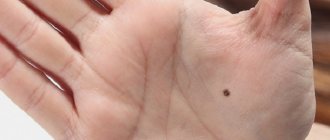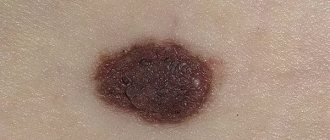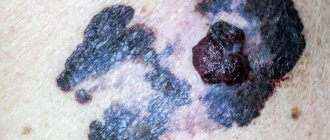What types of skin formations are there?
Most often, birthmarks, moles and warts can be found on human skin. Each of these formations has its own reasons for its appearance, as well as recommendations for removal if necessary.
What is a wart
This neoplasm is the result of the activity of the human papillomavirus. When HPV is activated as a result of weakened immunity, skin cells begin to transform, resulting in various types of papillomas, condylomas and other growths appearing on its surface.
What you need to know about moles
Unlike warts, they are not caused by a virus. The predisposition to the occurrence of these formations can be genetic, and also develop over time due to hormonal changes in the body. They are absolutely harmless and do not require removal. Exceptions are those cases when a mole becomes injured, begins to grow, or a person simply does not like it because it is on an open area of the body.
Moles like warts - verrucous nevus
This is a pathology in which a mole is similar to a wart, that is, it has a pinkish-brown or black color and a loose, rough structure that resembles a growth. Warty nevus most often affects women and is considered a cosmetic defect. Many people also get rid of such moles because they constantly touch them with clothes.
What is a mole
Moles are a fairly common occurrence; 75% of Caucasians have them. They are formed as a result of accumulations of nevocyte cells containing large quantities of melanin, a pigment that colors the skin dark. This explains their other name - nevi. The color of the mole can vary from light to dark brown, almost black.
There is such a thing as a warty nevus, which is the same benign formation that looks like a wart. It must be monitored especially carefully, since its shape can contribute to the degeneration of cells into abnormal ones.
The appearance of moles is primarily due to genetic predisposition. Most of them appear in the first years of life (unlike warts), others during puberty. In rare cases, new formations may appear in adults.
Possible reasons for their appearance include:
- Heredity. This applies to formations that appear in a child after birth.
- Hormonal changes (changes in the levels of progesterone and estrogen in the body). This explains the appearance of nevi in pregnant women and adolescents.
- Ultraviolet light, which causes changes in the skin. Nevi can appear after prolonged exposure to the sun or in a solarium. This can also cause a mole to turn into an oncological formation.
- Sexually transmitted diseases.
- Inflammatory processes in the genitourinary system.
- Poisoning with toxic substances, including alcohol.
Must read Warts on feet, where they come from
In most cases, nevi do not pose any danger and do not require removal. The exception is moles that turn malignant.
Important! If a mole changes color, shape, begins to bleed, or is damaged, you should definitely contact a dermatologist to have it examined. If an oncological problem is detected in time, it is easier to treat.
How to distinguish a wart from a mole
All neoplasms have similarities and differences, so some nevi can be mistaken for papillomas. How to determine whether a mole or wart is a new formation? It is enough to know a little about the characteristic features of these formations.
Fundamental difference
The main difference between a wart and a mole is that the second category of formations is not viral, but genetic in nature. Simply put, the tendency to develop moles is inherited. And warts occur due to the presence of papillomavirus in the body, which can be caught through contact with a sick person.
Quantity and location
Moles and warts differ in area of localization. If the result of exposure to HPV can often be seen on the surface of the hands, in the axillary and groin areas, as well as on the face and genitals, if there was infection with the virus during sexual intercourse, then the nevi are distributed over the entire surface of the body.
Typically, warts appear in groups, while nevi are single formations.
Causes of moles and warts
As mentioned above, the source of warts is a virus found in the human body. The disease occurs when the immune system's defenses are reduced, which usually occurs as a result of:
- Excessive load on the nervous system.
- Neglect of hygiene rules, which makes it more difficult for the body to fight a large number of different microbes.
- Poor nutrition, because a lack of vitamins and minerals leads to vitamin deficiency, and the body has nowhere to get the strength to fight diseases.
- Any previous illness. Even while fighting a cold, a person weakens and the papilloma virus can become more active.
Because of their appearance, moles are very different from warts. As a rule, they appear on the body of children before the onset of puberty. In the future, new formations may appear due to changes in hormonal levels. For example, some women may develop new moles during pregnancy.
Difference in shape and surface structure
When figuring out how a wart differs from a mole, one cannot ignore the appearance of these formations. A wart is a rough growth that often extends deep into the epithelium. The structure of such growths seems unpleasant to look at; sometimes thrombosed vessels are visible inside the wart, mistakenly taken for its roots.
The surface of moles is soft and smooth. Some of them are not even palpable when touched, more like spots on the skin than any formations. By the way, in addition to moles, there are also birthmarks - areas of skin with altered pigmentation, which can have any shape and be located on different parts of the body.
Moles look as if they are glued to the body, because they do not go deep under the skin and have a slightly convex shape.
Color Difference
By analyzing the color of different formations on human skin, you can easily understand the difference between a mole and a wart. Manifestations of papillomavirus most often show a pink or red color. The color of the growths depends on the location. A black wart most often appears on the hands and face, and pink or red condylomas form in the genital area and armpits. Papillomas in the sole area are light in color.
Moles are much more varied in color than papillomas. They can be colored in various shades of purple, red and brown. As a rule, the shade is completely uniform.
Other differences between moles and warts
When determining the nature of a neoplasm on the skin, it would be useful to pay attention to the body’s reaction at the site of its appearance. Birthmarks do not cause itching or pain, while various forms of papillomas can cause significant discomfort. For example, having plantar warts on the foot can cause pain when walking. A mole hurts only in two cases: if it is injured or when it begins to transform into a malignant formation.
Why are they dangerous?
Most skin growths are benign. And nevi without turning into a malignant form will not cause any problems to their owner. But warts can lead to serious problems even without the threat of skin cells turning cancerous.
The moment papillomas appear, a person becomes more contagious to others.
Warts, unlike moles, often cause disgust both in their “carrier” and in other people, which can prevent them from leading a full life.
Neoplasms caused by papillomavirus can lead to various complications. Thus, warts on the fingers can spread to the tissues of the nails and lead to their damage, and condylomas on the genitals can penetrate the urinary tract, causing partial or complete obstruction.
What is a wart?
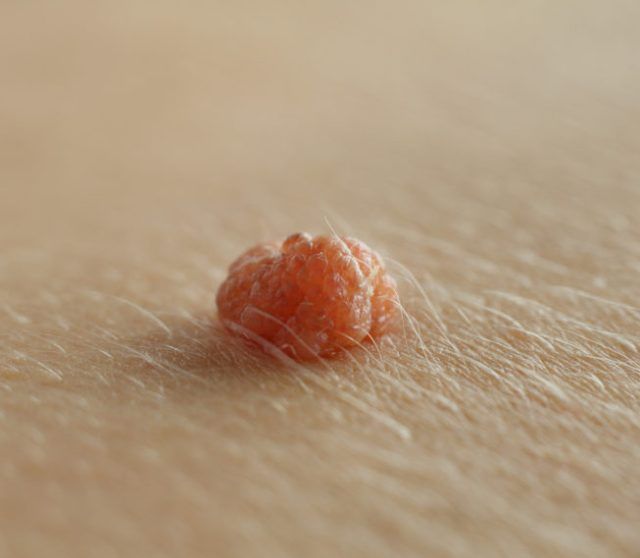
Photo of warts on the body
Warts, unlike moles, have a different nature of origin. They are caused by human papillomavirus of various strains. Under its influence, epidermal cells begin to divide pathologically quickly. This is how the skin grows in the form of nodules and papillae.
These are also benign growths, but like moles, warts can develop into malignant tumors.
Factors contributing to the activation of HPV are:
- Increased sweating due to heat, as well as hyperhidrosis;
- Various mental traumas, stress, chronic fatigue;
- Poor state of the immune system;
- Improper lifestyle - unbalanced diet, poor sleep, low physical mobility, bad habits;
- Hormonal fluctuations.
This virus is easily transmitted from a sick person to a healthy person, as it is highly contagious. You can pick it up in any public place, especially where there is high air humidity. Most often, warts occur in children due to the way their immune system works.
The appearance of warts depends on which strain of the pathogen has “settled” in the human body. There are more than 100 types of HPV. Some types cause papillomas and condylomas, while others are responsible for the appearance of the following types of warts:
- Vulgar (ordinary) . These are growths with a dense structure, they are covered with the stratum corneum of the skin and resemble a rounded nodule. They have a lumpy, rough surface, the color ranges from yellowish to grayish. Usually appear on the hands, elbows, knees. They are painless and do not cause noticeable discomfort.
- Plantar . Affects the feet and toes. They are similar to corns, but have a number of distinctive features: they are painful, may have black dots on the surface (traces of clogged capillaries), and if damaged, can bleed heavily. Their color is usually yellow or brownish.
- Flat (youthful) . The difference between moles and warts of this type is that viral growths can go away on their own over time. The factor that causes their appearance is hormonal fluctuations during adolescence. Once hormones stabilize, juvenile warts go away on their own. Most often, these tumors are found on the hands, elbows, neck and face. They do not cause significant discomfort. The color is practically no different from healthy skin.
There are also senile warts, but the cause of their appearance is not viral. They arise due to the natural aging processes of the body and resemble loose plaques with a horny coating.
Note! It is important to know what types of moles and warts there are in order to accurately determine what kind of tumor you are dealing with. But it is optimal if the diagnosis is made by a specialist during a visual examination, as well as based on the results of laboratory tests.
How is diagnostics carried out in the clinic?
The difference between a nevus, papilloma, condyloma, a wart of another group, or a manifestation of a skin disease is not always obvious. For this reason, it is possible to find out whether a growth that has popped up on the skin is a wart or a sign of other diseases only after undergoing tests. During the initial examination, a dermatologist can only suspect a manifestation of papillomavirus. But since warts in the genital area may have a nodular shape similar to genital herpes, and a growth on the skin of the arm may turn out to be dermatofibroma, any doctor will first send the patient for testing. As a rule, papillomavirus is found in the blood of seven out of ten people.
If you suspect sexually transmitted infection, your doctor will advise you to get tested for HIV, syphilis and other diseases transmitted during unprotected sex.
Origin
Warts
The main difference between a mole and a wart is its origin. Warts appear on the skin due to the human papillomavirus, which is transmitted from one infected person to another. You can catch the virus anywhere: you shook the hand of a sick person, shared the same towel, visited the same sauna or swimming pool. The likelihood of catching the virus increases if there are scratches, wounds, or cuts on the skin.
Through them the virus enters the skin. However, growths on the body do not appear immediately. Sometimes it takes a couple of years for them to grow on the skin. The virus is activated if the patient’s body is weakened and his immune system cannot cope with it.
The wart is of viral origin
Moles
How are moles different from warts? You cannot catch them from another person, or become infected with them through communication or visiting public places. A baby is born without pigment spots, but gradually they appear on the skin, sometimes disappear, and then reappear.
Most moles make themselves known before the age of 25, but appear at any time in a person’s life. Why? There are many reasons. There are pigment spots, information about which is embedded in DNA. In children they appear in the same place as in parents or other older relatives.
The second reason is the sun's rays. Under their influence, the human body produces melanin. This substance forms the basis of moles. Hormones also influence the appearance of these marks, so due to a hormonal surge, new spots appear on the human body. Such surges of hormones occur in women in an interesting position or in adolescents during the restructuring of the body during the period of growing up. At this time, new moles appear on a person’s body or old ones disappear.
Typically, all moles appear before the age of 25.
Moles are like warts
Can a mole become a wart? No, it cannot, because they are not connected in any way, although a similar growth may grow next to it, but it will appear on its own, due to the action of the virus. Even if a mole looks like a wart, this does not mean anything. There is such a type of mole - warty nevus. These are congenital neoplasms that are more common in girls. In a person at an early age (they practically do not appear in adults), a mole similar to a wart appears. This can be one growth, not exceeding 1 cm in diameter, or a garland of moles. Such neoplasms grow slowly, and most often grow in height, and their diameter also increases. How can you tell if it's a wart or a mole? It appears only in children. Those who have doubts should visit a dermatologist who will examine the tumor and conduct a series of instrumental tests. But even such a mole cannot become a wart. A wart nevus is not dangerous and no treatment is required. But you need to visit a doctor if the following symptoms appear:
- It began to quickly grow in width and height.
- If nothing bothered you before, but suddenly the growth began to itch, tingle, hurt, and peel.
- It changed color and became darker. Or hairs have grown on it.
- Liquid or blood oozes from it.
- The contours of the nevus became less clear.
Warty nevus occurs predominantly in women
When tumors need to be removed
The appearance of a wart is an unpleasant event for many people. Such skin pathologies can be treated with conservative methods or radically removed using the achievements of modern medicine. You need to know that getting rid of warts is mandatory if they threaten to develop into cancer. In addition, after getting rid of the growths, you will need to undergo therapy with antiviral drugs.
People get rid of moles when they consider them cosmetic defects, or there is a threat of developing cancer. It is indicated to get rid of moles that are located in places that are rubbed by clothing, when there is a risk of injuring the formation and causing complications.
Papillomas and other skin formations
Papillomas appear more often in dark and damp places. They can be seen not only in the groin and armpits, but also on the oral mucosa, vocal cords and even on internal organs such as the bladder and intestines. It is worth noting that this never happens with a mole.
The papilloma virus is not only dangerous, but also very common
. According to statistics, about 60% of the world's population is infected with it. The emerging neoplasms have become so diverse that among them you can find small-sized wen, pimples of incomprehensible shape, filled with liquid, etc.
Among the common formations:
- acrochordon
(a growth on the skin very similar to a thin thread that appears on the neck or face); - wart
(a common type of papillomas that can be localized on any part of the body); - cutaneous horn
(has the characteristics of a mole and often appears on open areas of the body).
Treatment and removal methods
Formations caused by papillomavirus can be removed using traditional medicine and pharmaceutical products. In difficult cases, you can resort to surgical methods for treating tumors. The most popular method of treating papillomas is electrocoagulation, during which a high-frequency electric current is passed through the tissues of the warts. This way you can get rid of moles. You can also perform laser excision, radio wave treatment, removal of formations with liquid nitrogen, and traditional surgery to excise a mole or papilloma.
It is best to make a decision about the need to remove the tumor and choose the method by which this procedure will be carried out with the help of the attending physician. Only a specialist will be able to choose the optimal treatment option, taking into account all the patient’s characteristics.
Differences between birthmarks and warts
Only a doctor can determine what type of tumor. There are methods for studying cells and tissues that help a specialist make an accurate diagnosis. The appearance of any changes on the body interests a person. So what is the difference and how to understand the difference between a nevus and a papilloma? There are differences for this, which are listed below.
Shape and structure
To determine the difference, you need to carefully examine the site of the nevus. To do this, use a magnifying glass or magnifying glass. A mole is most often flat, and a wart is a growth on the skin. To evaluate the structure, you need to feel the growth. Papillomas have a rough surface. They are a little harsh due to keratinized cells. Birthmarks are smooth and feel softer to the touch.
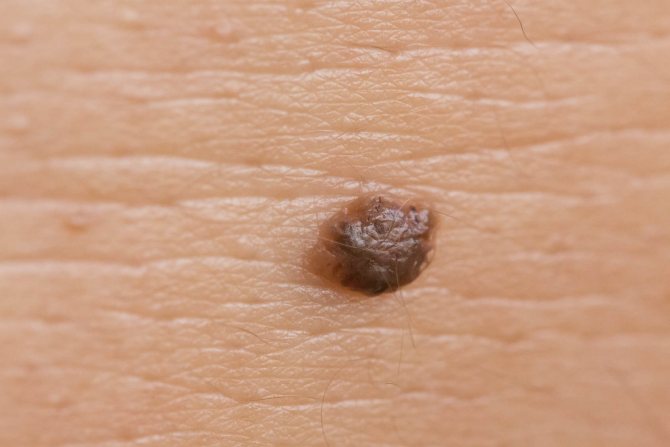
Moles are usually darker in color than warts.
Color and shade
This is a very simple way to help identify the differences. Thanks to melanin, the nevus is darker in color. The most common colors are red, brown and black. Warts on the human body occur in light shades. They are white, flesh-colored and slightly pinkish. Sometimes they are yellow and gray. Therefore, it is enough just to carefully examine the color, although this does not guarantee a 100% correct diagnosis.
Quantity and location
Birthmarks are much more common on the human body than warts. Moles appear on the human body from the moment of birth and their number increases during life. The formation of papillomas is influenced by both external factors and internal changes in the health of the body. Warts have their own peculiarity. If they are located close to each other, they may grow together. Moles are located separately. However, if a mole or wart appears on the body, it is best to have it examined by a dermatologist.


